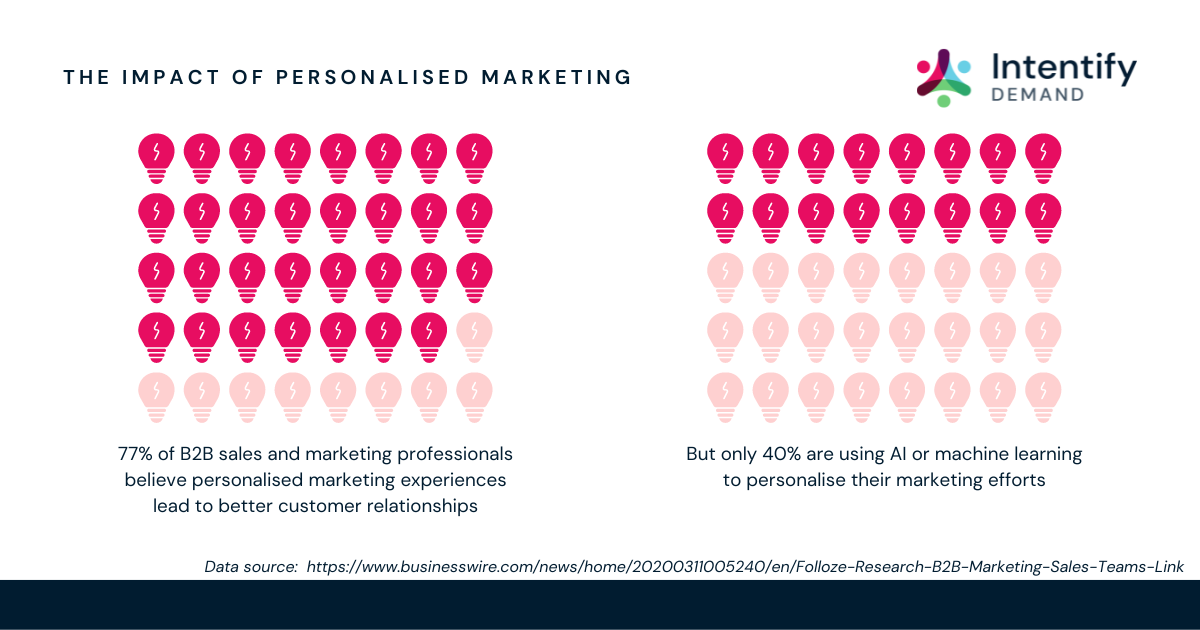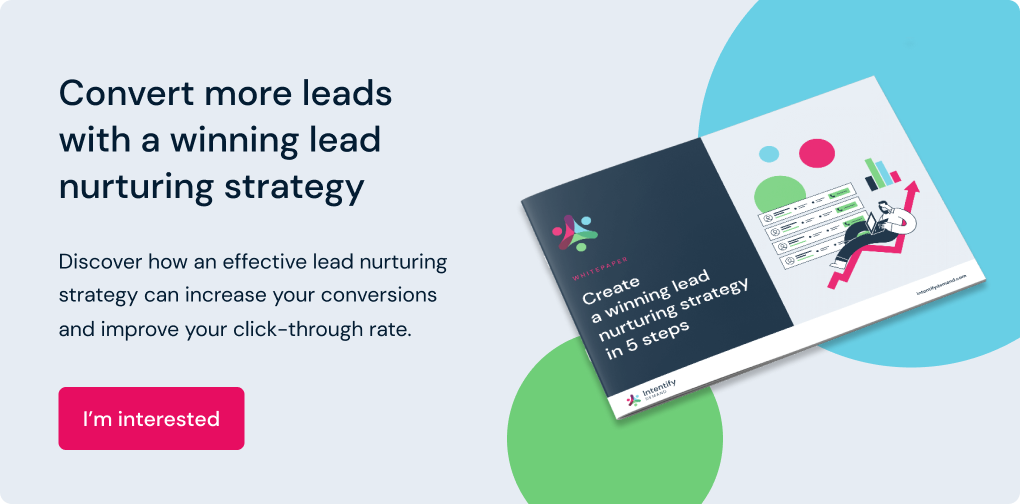Read time: 6 minutes
Technology is advancing, but budgets are getting tighter. And as the market becomes more competitive, ensuring budget is being spent well is crucial to getting the most from your marketing strategies.
With customers (in both B2B and B2C markets) now expecting hyper-personalised experiences, brands are being pushed to deliver tailored messaging and customer-centric strategies.
Relying solely on demographic data to achieve this is no longer enough as it only provides a basic understanding of your audience and often falls short in capturing the nuances of buyer behaviour in the decision-making process.
As a result, integrating intent data into your B2B marketing budget is no longer optional—it's a necessity for staying competitive and cutting through the noise. By leveraging intent data, marketers can ensure they deliver the right message to the right audience at the right time.
This targeted approach not only increases the effectiveness of marketing campaigns but also enhances the overall customer experience, leading to higher conversion rates and greater customer satisfaction.
So why is it then that only 47% of B2B marketers are actually using intent data?
Despite its value, more than half of B2B marketers have been unable to include intent data in their marketing budgets. And that needs to change.
Why add intent data to your marketing budget?
It's shocking to learn that so many B2B marketers have yet to benefit from the power of intent data. Whether it's the cost of implementation, the measurement of ROI or something else entirely, there are clearly some barriers to including intent data when planning marketing activity.
Recommended reading: Can high-intent leads boost your marketing ROI?
It's not enough to simply say intent data needs to be in your marketing plan. Here we're going to outline 5 reasons why you need to include intent data in your marketing budget.
1. Shorter sales cycles
While the average B2B sales cycle takes around 1-3 months, for some this can take much longer. And in some cases, it can take as long as 12 months.

However, there are some obvious benefits to shorter sales cycles:
- They require less time investment from sales reps who can go after other deals
- This means an increase in revenue as more deals get closed
- Which reduces the chance of a deal not going through
- And makes for a smoother buyer's journey
Plus, a shorter sales cycle means better conversion rates which in turn increase customer retention due to a better overall purchase experience.
But how does intent data help with this?
By better understanding your target audience, you can create relevant content that aims to be useful while also educating them about your products. This is important because it means you're less likely to waste time communicating with individuals who might not be ready to purchase yet.
Using purchase intent, you can see where in the buying journey your potential customers are and focus your time and energy on providing them with the resources they need to make an informed decision.
This type of targeted marketing eliminates cold outreach tactics that waste time, energy and resources, and instead only focuses on those with a high propensity to convert.
2. Up-to-date target account lists (TAL)
Things change fast. Specifically data. And with over a quarter (25-30%) of it becoming out of data within a year, working from a static TAL for your account-based marketing (ABM) is a big mistake. Especially if that list was built from demographic data, as there's no true indication of whether those accounts are in-market to buy.
Recommended reading: Personalisation is only as good as your data: Improving data accuracy
The trick is to use intent data to construct audiences similar to the prospects in your existing database and identify which accounts you may have missed when building your TAL, while also looking at whether they're actively looking for a solution.
3. Better customer retention
The average customer acquisition cost for B2B businesses is $525, based on data from First Page Sage. As you can imagine, it's a lot less expensive to market to current customers in comparison. As a result, marketing teams should focus on strategies that reduce customer churn and leverage upsell opportunities to keep customers engaged and happy.
Using first-party intent data makes this much easier.
Intent data relies on signals from online behaviour that can help to provide insight into an individual's purchase intent. For example, if you notice customers researching a competitive solution, there may be gaps in your offering. These need to be addressed, and fast. On the other hand, if customers are researching an additional solution that you already offer, you can approach them with timely marketing communications.
4. Improved lead targeting
83% of B2B buyers research online before making a purchase. And it used to be that these potential customers would remain hidden until they completed a download form or signed up to a newsletter.
While intent data isn't magic, it is able to identify these potential customers before they hand over their information in a form. It does this by aggregating data sets on what content they're consuming, what platforms they're visiting and what topics they're researching. This not only helps to identify current industry trends, but also specific users that are researching your market, or already engaged in the buying process.
Armed with this information, you can create tailored content that builds relationships with these highly engaged leads.
Well-executed demand generation marketing gives prospects the information they need, at the right time, to guide them through the buying process. It's about knowing which accounts in your target audience are getting ready to buy and how to deliver the right content that catches their attention.
5. More effective content
When you have a pipeline full of highly qualified leads, you can create content that speaks to their problems and sells your solution. But one big issue still remains: how do you know which (if any) of your content visitors are the right ideal customer profile (ICP)?
Simply put: you don't.
With intent data, you remove the guesswork from this process. You have a clearer picture of the interests, needs and online behaviour of your prospects without needing to spend money or effort on campaigns that may or may not hit the mark.
So not only are you able to create a content strategy that specifically targets these pain points, you can also ensure it's delivered to the right buyer personas at the right moment in their purchase journey.
How are we using AI to make intent data better?
77% of B2B sales and marketing professionals believe that personalised marketing experiences lead to better customer relationships. Despite this, 60% still aren't using AI to personalise their approach.

This is a wasted opportunity for many.
Pelago, our custom-built AI, uses first-party intent data to target the right prospects based on specific campaign criteria. With a 95% degree of accuracy, our data allows you to target the topics your prospective customers are actively searching for, so you don't waste budget on creating irrelevant content or ineffective campaigns.
Recommended reading: Pelago Solus: Inside our new CPM model
It's a lead generation service unlike any other; we deliver qualified leads who want to engage with a product or service like yours. And it's this approach that increases engagement, boosts profitability, and shortens sales cycles.
This article was updated 20th February 2024.




